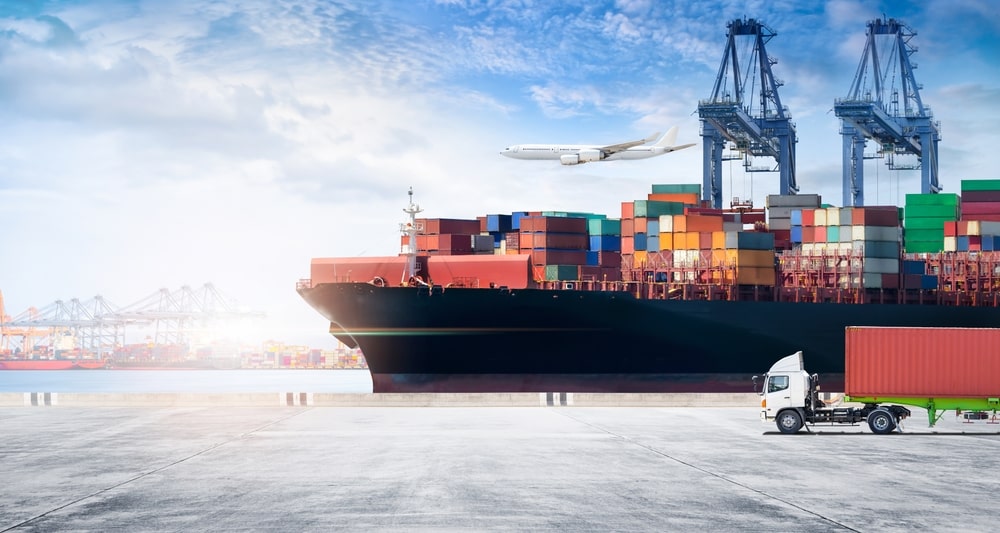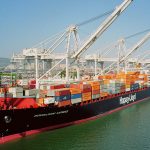Freight on Board (FOB) Explained: A Comprehensive Guide for Importers and Exporters
This is a guest post by Diana Zheng.
The seamless movement of goods across international boundaries is crucial for businesses involved in global commerce. Among the many terms and regulations controlling these transactions, “Freight on Board” (FOB) is a critical idea that defines the crucial point at which ownership and responsibility for goods shift between sellers and buyers.

This guide intends to simplify the complexities of FOB, serving as a helpful resource for importers and exporters alike. From its basic meanings to the subtle differences between FOB Origin and FOB Destination, let’s explore the core principles that underpin this international trade term.
Key Takeaways
- Crucial for importers and exporters, FOB outlines the location where the buyer assumes shipping costs and risks, influencing trade agreement terms. Clarity minimizes uncertainty, ensuring a smooth transfer and enhancing the efficiency of global trade.
- FOB terms play a pivotal role in a sales contract, necessitating a precise definition of ownership transfer, responsibilities, and the allocation of risks.
- Strict adherence to FOB terms is paramount, providing clarity on financial implications in unforeseen events during transportation and ensuring effective risk mitigation strategies are in place.
Definition of Basics of FOB
It is an international trade term indicating the starting point at which responsibility and ownership for goods move from the seller to the buyer during shipment. It is also known as Free on Board. The terms are used interchangeably to describe a shipping agreement and signify the same rules and conditions regarding the transfer of risk and costs in international transactions.
Understanding FOB is crucial for importers and exporters as it outlines essential aspects of the shipping and delivery process. In global trade, FOB defines the location where the buyer pays the freight shipping costs and risks associated with transporting the goods, influencing the terms and conditions of the trade agreement.
This clarity minimizes uncertainty, ensuring a smooth transfer of goods and facilitating transparent negotiations. Determining ownership and responsibility at a defined location enhances the efficiency and reliability of global trade transactions.
FOB Origin Vs FOB Destination
FOB Origin and FOB Destination represent two variations of the FOB international shipping term, specifying when ownership and responsibility for goods transfer between the seller and the buyer.
FOB Origin
In FOB Origin transactions, the buyer assumes control of freight costs, and risks associated with transportation from the moment of loading. This arrangement gives the buyer more control over the shipping process, carrier selection, and shipment timing, influencing the overall logistics strategy.
Ownership Transfer
It occurs when the shipping goods are loaded onto the carrier at the seller’s premises. At this point, the buyer assumes ownership, taking on transportation’s associated costs and risks. This transfer outlines when the buyer gains control over the shipped goods, influencing logistics decisions and contractual obligations in the trade transaction.
Responsibilities
In FOB Origin transactions, the seller’s responsibilities include:
- Preparing and packaging the goods for export.
- Loading the goods onto the specified carrier at their premises.
- Completing export customs clearance.
On the other hand, the buyer assumes responsibilities such as
- Paying for transportation costs.
- Managing import customs clearance.
- Unloading and transporting the goods from the destination port onwards.
This division of duties traces each party’s distinct responsibilities in facilitating the seamless movement of goods from the seller’s warehouse to the buyer.
FOB Shipping Point
Under FOB Origin, the buyer has the majority of the shipping control. The buyer takes responsibility for the shipping process as ownership and responsibility are transferred when the seller’s location is where the carrier is loaded with the goods. This involves planning the shipment, selecting the carrier, and deciding on the routing. The buyer’s influence extends to logistics decisions, and freight charges, allowing for strategic choices in transportation methods and ensuring alignment with their specific requirements and preferences.
FOB Destination
In FOB Destination transactions, the seller retains control, bears costs, and assumes risks associated with transportation until the goods reach the agreed-upon destination. With this arrangement, the seller has greater control over the logistics planning, carrier selection, and shipping process until the items arrive at the buyer’s location.
Ownership Transfer
It occurs when the goods reach the buyer’s specified destination. Until this point, the seller retains ownership, covering the associated costs and risks of transportation. The transfer marks the exact moment in the transaction where the buyer takes custody of the received items, affecting contractual obligations and logistical choices.
Responsibilities
In FOB Destination transactions, the seller’s responsibilities include:
- Preparing and packaging the goods for export.
- Loading them onto the specified carrier.
- Completing export customs clearance.
Additionally, the seller is responsible for transportation costs, import customs clearance, and the unloading and transportation of the goods from the destination port to the buyer’s specified location. This distribution of responsibilities delineates each party’s distinct roles in ensuring the secure and efficient delivery of goods to the buyer’s destination.
FOB Shipping Point
In FOB Destination, shipping control primarily rests with the seller’s shipping dock. Until the goods reach the buyer’s specified destination, the seller maintains authority over the shipping process, including carrier selection, routing, and overall logistics planning.
The seller’s influence extends until the goods reach the agreed-upon destination. This arrangement allows the seller to strategically manage the transportation process and ensure the secure and timely delivery of the goods to the buyer’s designated location.
FOB and Incoterms

Apart from FOB, there are other International Commercial Terms (Incoterms) that you need to learn about. These terms are a universal language, providing clarity and consistency in trade agreements. These standardized terms, published by the International Chamber of Commerce, define the rights and responsibilities of buyers and sellers in international transactions, resolving risks and uncertainties.
FOB vs EXW
FOB designates ownership transfer when goods are loaded on the carrier at the seller’s location, with the buyer taking responsibility for the shipping. In contrast, EXW (Ex Works) places maximum responsibility on the buyer, as the ownership transfers at the seller’s premises, and the buyer manages the entire shipping process. The buyer pays the costs and covers the risks from the point of origin to the destination.
FOB vs CIF
FOB transfers ownership at the loading point onto the carrier at the seller’s location, with the buyer taking responsibility for shipping. In CIF (Cost, Insurance, Freight), ownership transfers when the ship’s rail goods are loaded, but the seller covers main carriage costs and provides insurance until the destination port. With a CIF agreement, the seller has more responsibility, paying for the transport costs and insurance, influencing cost distribution and risk allocation.
FOB vs DAP
FOB transfers ownership, with transport cost and insurance responsibilities, at loading on the carrier at the seller’s location, with the buyer taking control. DAP, however, shifts ownership and responsibility at the buyer’s specified destination, while the seller pays all the costs and risks until unloading. With FOB, the buyer takes responsibility. Meanwhile, DAP places more responsibility on the seller for the transport costs, streamlining the delivery process to the buyer’s designated destination.
Benefits of FOB
The use of FOB in international shipping offers several benefits for both sellers and buyers:
- Clear Allocation of Freight and Shipping Costs. FOB delineates costs, specifying when the buyer assumes responsibility for transportation expenses. This transparency aids in budgeting and financial planning.
- Control Over Transportation. FOB allows the buyer to control the shipping process, carrier selection, and the timing of shipments. This can offer benefits to businesses with particular logistics needs.
- Flexibility in Shipment Carrier Option. FOB enables the buyer to choose the carrier based on their preferences and requirements, providing flexibility in managing the transportation of goods.
- Risk Mitigation. FOB helps in clarifying the transfer of risks. Once ownership transfers, any damages or losses during transportation are typically the buyer’s responsibility, reducing ambiguity and potential disputes.
- Simplified Logistics Planning. The clear transfer point in FOB simplifies logistics planning for both parties, making it easier to coordinate the shipment and ensuring a smoother process.
- Cost-Efficiency. FOB can lead to cost savings for buyers who choose cost-effective shipping methods and carriers based on their specific needs.
- Negotiable Terms. Negotiations between the buyer and the seller determine the FOB terms, allowing them to tailor the agreement to their specific circumstances and preferences.
- Sustainability for Certain Industries. FOB is particularly suitable for industries where the buyer understands transportation logistics, allowing them to optimize shipping processes and costs.
To harness the advantages of FOB, one must engage in meticulous negotiation and take into account the distinct needs and preferences of both parties participating in the global trade transaction.
FOB and Insurance
FOB in global trade does not inherently include insurance coverage for the goods transported. While FOB outlines the transfer of ownership and responsibility, it is crucial to note that insurance is not automatically provided. Specifying insurance paid separately on freight invoice is essential to safeguard against potential risks, damages, or losses when transporting goods.
This separation allows parties to tailor insurance coverage to their needs, ensuring comprehensive protection. Please clarify insurance terms to ensure the buyer can avoid unforeseen events. Therefore, explicit agreement on insurance details is essential for a well-defined and secure global trade transaction under FOB terms.
Documentary Requirements
In FOB transactions, several key shipping documents are vital in facilitating the smooth transfer of goods from the seller to the buyer. Two crucial documents in this context are the Bill of Lading (B/L) and the Commercial Invoice.
Bill of Lading
The Bill of Lading is a crucial document issued by the arrival port to the carrier or its representative, confirming the receipt of goods and detailing their type, quantity, and condition.
Functions
- Receipt. It is a receipt for the goods, confirming that they are now on the carrier.
- Document of Title. Acts as a document of title, allowing the buyer to claim the goods upon arrival at the destination’s shipping port.
- Transfer of Ownership. The transfer of the Bill of Lading may signify the transfer of ownership rights.
Commercial Invoice
The Commercial Invoice is a document issued by the seller, providing a detailed account of the goods being sold.
Functions
- Identification. Identifies the buyer and seller, specifying the goods’ quantity, description, and value.
- Customs Clearance. Aids in customs clearance by providing the necessary tax assessment and compliance information.
- Payment. Serves as a basis for payment, enabling the buyer to understand the costs associated with the purchased goods.
Shipping Costs with FOB
In an FOB arrangement, the allocation of shipping costs between the seller and the buyer depends on whether it’s FOB Origin or FOB Destination:
FOB Origin
- Seller’s Responsibility. The seller bears the costs related to transporting the goods to the port of shipment, covering expenses such as inland transportation, export duties, and loading onto the vessel.
- Buyer’s Responsibility. The buyer takes on the responsibility and costs of loading the goods onto the vessel. This includes ocean freight, unloading costs at the destination port, import duties, and further transportation to the final destination.
FOB Destination
- Seller’s Responsibility. The seller assumes the expenses for transporting the goods to the destination port, encompassing inland transportation, export duties, and loading onto the vessel.
- Buyer’s Responsibility. The buyer assumes responsibility and covers the costs from the destination port onward. This includes ocean freight, unloading costs, import duties, and transportation to the final destination.
Key Considerations
Negotiability of FOB Terms
Negotiable between the buyer and the seller, FOB terms offer flexibility to customize the agreement according to their needs. The parties can collaboratively determine various aspects, such as the precise point of transfer, the selection of the carrier, and specific responsibilities. This negotiation allows for a customized arrangement that aligns with both parties’ preferences and logistical considerations.
Legal Implications and Obligations
Comprehending the legal ramifications of FOB terms is essential to prevent disputes and ensure a seamless international trade transaction. These legal considerations include the following:
- Contractual Agreement. FOB terms are typically outlined in a sales contract. Both parties must clearly define their obligations, responsibilities, and the specific terms governing the transfer of ownership and risk.
- Risk of Loss. FOB outlines the shift of the risk of damage or loss of goods to the buyer from the seller. Adhering to this agreement is crucial to ascertain which party assumes the financial consequences of any unforeseen events during transportation.
- Customs Compliance. The buyer and seller must comply with customs regulations and documentation requirements. Please do so to avoid delays, fines, or other legal issues.
- Incoterms Compliance. FOB is one of the Incoterms published by the International Chamber of Commerce. Adhering to the agreed-upon FOB terms ensures compliance with international trade standards and regulations.
- Documentary Requirements. Proper documentation, including the Bill of Lading and Commercial Invoice, must be prepared and exchanged by the FOB terms to facilitate the smooth movement of goods and customs clearance.
- Dispute Resolution. Clear FOB terms can serve as a basis for resolving disputes. If disagreements arise, parties can refer to the agreed-upon terms to find resolutions, preventing protracted legal battles.
Both parties must fulfill their obligations, mitigate risks, and maintain a positive and trustworthy business relationship to ensure clarity, transparency, and legal compliance in FOB agreements.
Final Thoughts
Understanding freight on board or free on board (FOB) is essential for importers and exporters in the complex world of global trade. As businesses delve into the negotiation process, the flexibility of FOB terms allows tailoring agreements to align with unique circumstances and preferences.
Legal implications, documentary requirements, and dispute-resolution mechanisms form the pillars of a secure and transparent FOB agreement. In conclusion, armed with this comprehensive guide, businesses can confidently embark on international trade journeys, leveraging FOB’s power for efficient, reliable, and legally compliant global transactions.

This was a guest post by Diana Zheng.
Author Bio
Diana leads the growth marketing initiatives at Stallion Express. As a personal trainer turned digital marketer, Diana is obsessed with equipping eCommerce entrepreneurs with everything they need to scale their online businesses. You can catch her doing yoga or hitting the tennis courts in her spare time.





